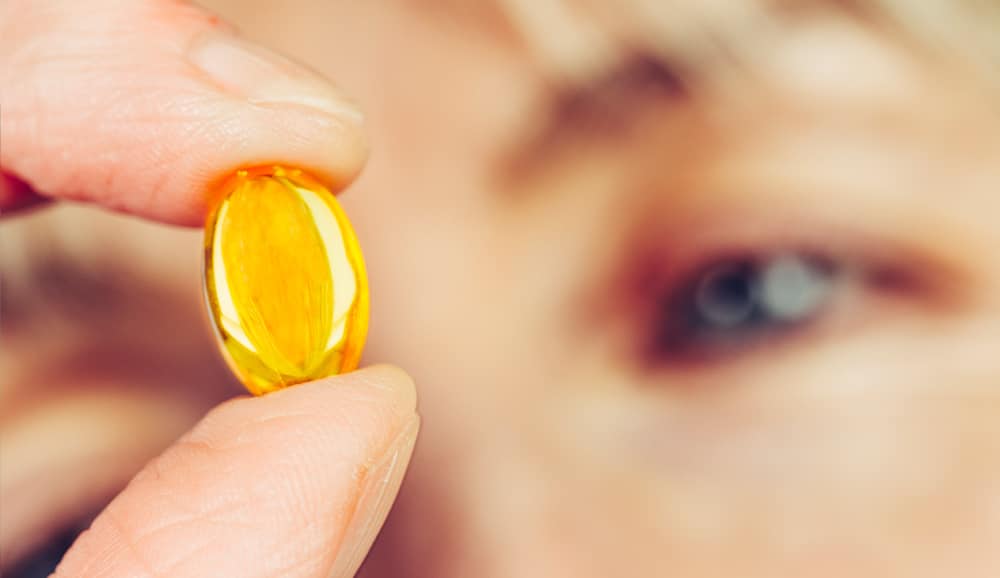Are Re-Esterified Omega-3 Products Better for Dry Eyes?
When Bo and I attended the CE Sarasota optometry conference last week, we got a lot of questions about a new dry eye study. This particular study, sponsored by PRN, concluded that consuming four PRN-brand softgels daily resulted in a significant improvement in dry eye signs and symptoms (1).
For those following the scientific literature on omega-3, this research is more good news. The study reconfirmed the importance of using omega-3 supplements as part of dry eye treatments. Of note, however, this study had used a concentrated and re-esterified triglyceride based fish oil to achieve its results.
What did we think of this re-esterified triglyceride form, the optometrists asked? And how did it compare to our Omega Cure® cod liver oil?
What Are Re-Esterified Fish Oils?
Before we can address what re-esterified triglyceride-based fish oils (rTGs) are, let’s go back and explain the reason for their origin.
A natural fish oil or cod liver oil contains a certain percentage of omega-3s, including the main EPA and DHA variety. The percentage of omega-3s can fluctuate, depending on the season, the type of fish harvested and if the fish oil has started to oxidize.
But on average, a natural fish oil will contain no more than 30% combined EPA/DHA (2). Since most regular fish oil capsules contain only 1000 mg of total oil per softgel, each capsule delivers at most 300 mg of EPA and DHA – a far cry from the dose featured in most studies showing positive results with omega-3 supplements.
The omega-3 concentrate market developed as an alternative for consumers frustrated with swallowing the approximate 10 capsules required to get an effective EPA/DHA dose. In creating concentrates, the manufacturers artificially pump up the concentration of EPA and DHA in an oil, altering the molecules into new chemical structures known as ethyl esters. Using this technique, the manufacturers can get between 50%-90% EPA and DHA in an oil (3, 4). For the consumer, this means swallowing only four capsules, instead of the handfuls described above.
These Concentrates Have Consequences Though
Studies have shown that ethyl ester oils are not as bioavailable as natural triglyceride-based fish oils (4, 5). Furthermore, scientists have questioned their safety, since ethyl esters are synthetic molecules, not found in nature. In fact, pregnant women and children are recommended against using ethyl ester products for safety concerns (6).
This negative response to ethyl esters has ushered in an interest in rTG fish oils. In making the rTG oils, the manufacturer still creates an ethyl ester omega-3 oil. But instead of stopping there, the manufacturer adds an extra step and removes the ethanol molecules from the oil, thus converting it to the re-esterified triglyceride form (6, 7). The point here is to achieve the same high EPA/DHA volume found in the ethyl ester products. But since it’s in a triglyceride form, it’s supposed to be more acceptable to the body.

Rancidity and Safety Questions
While rTG oils, like PRN’s products, address some of the ethyl ester bioavailability and safety concerns, they leave plenty of questions still on the table.
First and foremost, there’s the question of rancidity. Biochemists will tell you that the more you work and alter an oil, the more trans fats and rancidity-linked byproducts you risk creating. This is a concern for rTG oils, where the omega-3 molecules have not just been chemically manipulated to create the ethyl ester form, but also further processed.
In addition, rTG oils are most commonly sold in capsules. People have the misconception that putting fish oil into a capsule somehow protects the integrity of the oil. Nothing is further from the truth. During the encapsulation process, the oil is exposed to heat and oxygen, and within a month, the oxidation level of the oil can increase significantly (8). The concern is that long term consumption of rancid fish oils can be unsafe. Indeed, researchers speculate that oxidized oil may contain carcinogens and cause arteriosclerosis (8).
Why Are Omega-3 Concentrates Problematic
The manufacturers of concentrated omega-3 products may also be throwing out the baby with the bathwater, so to speak. The pumped up EPA and DHA levels replace the other omega-3 members and nutrients found in natural oils. So while fresh fish or cod liver oil contain dozens of different fatty acids and vitamins, as well as important nutrient co-factors, the concentrated fish oil leaves you with basically just two chemically-modified nutrients.
While it’s true the majority of omega-3 research has concentrated on EPA and DHA as the main workhorses of the omega-3 family, some of the latest brain research indicates it’s not just those two molecules at play. Other types of omega-3s, like DPA, and nutrient co-factors also seem to be important for brain health (9) and fighting cancer (10). We still have a lot to learn about how these molecules work in the body. But it may well be that these nutrient co-factors or the synergy of the fatty acids together can explain why studies suggest eating fish or natural fish oil provide greater benefits.

Are Re-Esterified Omega-3 Products Worth It?
Given the concerns above, it merits asking if rTG omega-3 products are worth it. To answer that, it depends on what we are comparing them against. Compared to expensive dry eye treatments like Restasis, rTGs are certainly more cost effective. And looking at regular fish oil capsules, rTGs provide the advantage of delivering a higher EPA/DHA dose per serving.
But the very purpose of these concentrated products becomes obsolete if you compare them against a truly fresh omega-3 oil, like Omega Cure.
There is no reason to put fish oil in a softgel, other than to disguise a rancid, bad-tasting product. If you simply start with a fresh, high quality fish oil, there ought to be no fishy taste or smell. In addition, one tablespoon of a fresh liquid cod liver oil delivers as much EPA and DHA as 10 regular fish oil capsules and five PRN softgels. In other words, truly fresh liquid cod liver oil solves the problems that started people chemically modifying their oils, while also avoiding the safety concerns voiced above.
Dry Eye Study Shows Promising Development
In the PRN dry eyes study, the researchers measured the omega-3 index score of its 105 participants. This was a welcome addition, since it allowed them to assess whether the patients were compliant with swallowing four capsules every day for 12 weeks. (As a side note, it is interesting that the omega-3 index they reported was significantly lower than what we’ve measured in people using one tablespoon of Omega Cure daily, but that’s a separate point!)
There were many positive aspects to the research. The study brought more attention to omega-3 supplements as a positive tool for helping people with dry eyes caused by meibomian gland dysfunction. The researchers also showed clear benefits in evaluating tear osmolarity and tear break-up time.
For all its positive findings, the study still leaves many unanswered questions about the long-term use of rTG oils for patients with dry eyes. We ask ourselves, why choose a chemically modified product when you can have a better omega-3 experience with our fresh and natural Omega Cure?
Try Exceptionally Fresh Omega Cure
Experience the Omega3 Innovations difference for yourself with the most effective fish oil supplement on the market.
Buy Now
References:
1. Epitropoulos AT, Donnenfeld ED, Shah ZA et al. Effect of Oral Re-esterified Omega-3 Nutritional Supplementation on Dry Eyes. Cornea. 2016; 35 (9): 1185–1191. doi: 10.1097/ICO.0000000000000940.
2. Omega-3 Fatty Acid, Fish Oil, DHA (docosahexaenoic acid), EPA (eicosapentaenoic acid).WorldHealth.Net. American Academy of Anti-Aging Medicine. December 30, 2005.
3. Alexander LJ. Is There a Difference Between Re-esterified Triglyceride and Ethyl Ester Fish Oil? Advanced Ocular Care. January/February 2011: 20 -21.
4. Dyerberg J, Madsen P, Moller JM, et al. Bioavailability of Marine N-3 Fatty Acid Formulations. Prostaglandins Leukot Essent Fatty Acids. 2010;83:137–141.
5. Fish Oils as Triglycerides vs. Ethyl Esters: Why This Matters. Ascenta Health.
6. Opperman M, Bennade S. Analysis of the Omega-3 Fatty Acid Content of South African Fish Oil Supplements: A Follow-Up Study. Cardiovascular Journal of Africa. 2013 Oct; 24(8): 297–302. Doi: 10.5830/CVJA-2013-074.
7. Why PRN? PRN Omega Health.
8. Albert BB, Cameron-Smith D, Hofman PL, Cutfield WS. Oxidation of Marine Omega-3 Supplements and Human Health. BioMed Research International, vol. 2013, Article ID 464921, 8 pages, 2013. doi:10.1155/2013/464921.
9. Dyall SC. Long-Chain Omega-3 Fatty Acids and the Brain: A Review of the Independent and Shared Effects of EPA, DPA and DHA. Frontiers in Aging Neuroscience. 2015; 7: 52. doi: 10.3389/fnagi.2015.00052.
10. UC Davis Researchers: Key Discovery Involving Omega-3 Fatty Acids and Cancer. UC Davis Department of Entomology and Nematology. April 1, 2013
Recent Posts
-
Omega-3, Weight Control
Anti-Inflammatory Diet: What To Eat & To Avoid
Inflammation is a double-edged sword. It’s the body’s natural defense system, springing into action to heal injuries and fight infections. But when it goes into overdrive and becomes chronic, it...2 weeks ago -
Dose, Omega-3, Omega3 Innovations News
How to Tell if Your Omega-3 Supplement Is Working
[vc_row][vc_column][vc_column_text]Whenever we pick up a new habit to improve our health -- be it working out with weights, cutting down on refined sugar, or taking three teaspoons of Omega Cure® every...1 month ago -
Omega-3
Can Omega-3 Fish Oil Help You Lose Weight?
Over the years, I've often heard people say, "I'm not sure about taking a fish oil supplement...won't omega-3 fatty acids make me fat?” Unfortunately, the notion that all fat is...1 month ago -
Omega-3
9 Foods That Are Very High in Omega-3s
Are you looking to boost your omega-3 levels? That’s a smart move, considering that a staggering 80% of people fail to get even half the recommended daily intake of these...1 month ago -
Brain Health
Does Melatonin Help With Anxiety?
Anxiety is on the rise, no doubt about it. In 2024, 43% of adults reported feeling more anxious than they did the year prior. That's up from 37% in 2023...2 months ago -
Omega-3
What Is DPA in Fish Oil? What You Should Know
In the omega-3 fatty acid world, there are plenty of types and acronyms that come to the family party. We've got EPA and DHA, the two omegas that usually take...3 months ago







